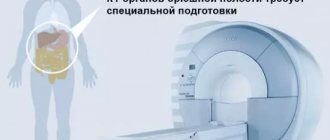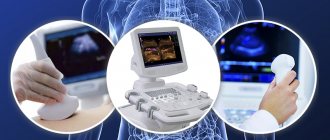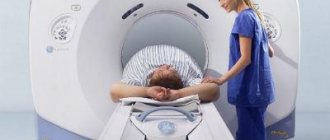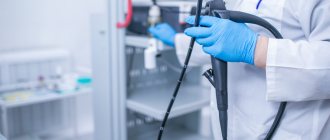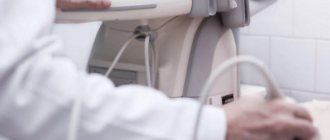Ultrasound of the internal organs of the abdominal cavity is a non-invasive, safe and, most importantly, reliable method for diagnosing internal diseases. It can be used to identify structural changes, the presence of pathological inclusions, as well as some functional changes. Ultrasound is prescribed not only for diagnosing and monitoring existing diseases, but also as part of preventive examinations, for the timely detection of pathology, when there are no obvious symptoms yet.
| Name of service | Price |
| Abdominal ultrasound | 4043 |
Attention! Prices may differ from those shown on the website. Please check the contact information provided for current information.
Ultrasound of the abdominal cavity: features of the procedure, how to prepare for it
Ultrasound of the abdominal cavity is a study of a complex of organs, allowing one to analyze their size and structure, determine pathological changes, and assess the activity of blood flow that predominates in large vessels of the retroperitoneal space.
Ultrasound examination is a universal technique that has no contraindications and restrictions on the number of procedures. It is used as a diagnostic measure, as well as to monitor the dynamics of recovery.
Ultrasound at home on a day off
Ultrasound examination on a weekend is a very convenient service for people who are at work on weekdays and are not able to undergo a full examination and visit a doctor. You can place a call by phone, choosing a convenient day off and the time of arrival of the diagnostician. In our clinic, specialists work seven days a week, seven days a week, and are ready to accommodate their patients.
An ultrasound scan on a weekend allows you to receive qualified assistance in emergency cases and undergo a scan without taking time off from work or sacrificing your everyday life. This is very convenient, especially for busy, working people who do not want to anger their bosses or lose money.
What does ultrasound of the abdominal organs include?
Using this method of examination, it is possible to identify all kinds of pathologies, determine the types of diseases, and identify them at the first stage, which leads to a relatively quick recovery.
Ultrasound examination is an informative technique, however, it must be taken into account that it can give false indicators. Therefore, abdominal ultrasound can be supplemented with additional research techniques, for example, laboratory tests to obtain a clear clinical picture.
What organs are looked at on an abdominal ultrasound:

- 1. Liver. The study identifies changes that have appeared in the organ due to concomitant diseases.
- 2. Gallbladder. Demonstrates the position of the organ, its dimensions, structure, contours and other parameters. Allows you to identify pathological foci of diseases, as well as identify formations, for example, stones.
- 3. Pancreas. Assess its size, structure, determine changes, inflammatory processes, if any. Ultrasound of this abdominal organ shows good results in diagnosing pancreatitis, oncology, diabetes and other diseases.
- 4. Spleen. The study is indicated for suspected pathological processes, mechanical damage, and blood-related ailments.
From an ultrasound examination of the abdominal cavity, patients mistakenly expect information about the condition of the organs of the reproductive system and digestive tract. But to obtain information on these departments, they perform a pelvic ultrasound and prescribe a number of other examinations.
What organs and systems can be examined at home?
At home, you can conduct an ultrasound examination of the following organs, systems, and tissues:
- pancreas, liver, gall bladder;
- mammary gland;
- kidneys, adrenal glands;
- thyroid;
- prostate;
- uterus, ovaries, appendages;
- bladder.
Also, outside the hospital, an ultrasound of the penis, scrotum area, lymph nodes, and submandibular glands is performed. Using Doppler, vessels and veins of the lower extremities are examined. Home diagnostics allows you to conduct fetal examinations in pregnant women.
When should you sign up for an abdominal ultrasound?
An ultrasound examination is usually prescribed by the attending physician. This could be a therapist or a specialist. However, you can visit the ultrasound room at your own request if you have certain complaints. Using the technique, it is determined whether an operation is required, or whether the disease can be combated by normalizing proper nutrition, a healthy lifestyle, and drug treatment. In our diagnostic center you can have an ultrasound of the abdominal organs, which is performed by a qualified specialist.
Ultrasound examination helps to identify the following pathologies:

- stones forming in the gall bladder;
- changes in the structure of the liver, including dystrophy;
- increased liver size, cirrhosis;
- oncological diseases;
- enlarged lymph nodes, infections caused by viruses;
- change in the thickness of the walls of the gallbladder, neoplasms;
- changes in the structure of all organs located in the abdominal cavity;
- damage, changes in the organs of the gastrointestinal tract, which were formed as a result of mechanical action;
- blood flow analysis and much more.
Preparing the abdominal cavity before an ultrasound allows you to obtain more accurate results and establish a diagnosis.
You should visit the ultrasound room if you have the following indications:
- prevention, which is carried out at least once annually;
- pain of an acute or aching nature, which predominates in the abdomen and kidneys;
- digestive problems accompanied by vomiting or nausea;
- change in the structure or color of stool;
- pain during bowel movements or urination;
- heat;
- abdominal trauma - in this case, the technique allows you to determine the presence of internal bleeding, ruptures of organ tissue;
- indications due to laboratory test results;
- observation of neoplasm;
- monitoring the condition of patients who receive long-term therapy against diseases of the kidneys, liver, spleen and other organs.
If necessary, an abdominal ultrasound can be supplemented with other studies that will provide a complete picture of the patient’s health condition.
Before visiting an ultrasound scan, you should make an appointment with a therapist or gastroenterologist, which is especially important if the patient experiences the following symptoms:
- a feeling of stiffness in the abdomen, which is accompanied by pain;
- a feeling of heaviness and fullness in the abdomen even after a bowel movement or during a diet;
- the appearance of bad breath;
- constant difficulties with bowel movements - constipation;
- gastrointestinal disorder for no apparent reason;
- changes in the structure of a particular organ when palpated;
- gas formation;
- causeless vomiting;
- mechanical injuries.
Moreover, ultrasound is relevant both before and after surgery, transplantation, etc.
Ultrasound at home on the day of treatment
Our clinic offers to perform an ultrasound at home on the day of treatment; to do this, you need to call the indicated numbers and place a call. Most often, our specialists arrive within a few hours after contacting, especially in the following cases:
- severe pain during menstruation;
- pain in the abdominal cavity, pelvis;
- bleeding, etc.
If the call is an emergency, then no preparation is required. In other cases, it is better to be prepared. If necessary, the operator may advise rescheduling the procedure to another day so that the person can follow the desired diet and cleanse.
Sign up for an ultrasound diagnostic by phone or by filling out the online form
| Select a clinic | All types of analyzes | Ultrasound at home | Calling a doctor to your home |
Diet
To properly prepare for an abdominal ultrasound in an adult, it is necessary to exclude foods that lead to gas formation. These include kefir and milk, cheese, dark bread, unprocessed fruits and vegetables. Also, avoid eating fatty meats and other foods. In the process of preparing for an ultrasound of the abdominal cavity, the following are acceptable:
- porridge;
- lean meat, fish;
- eggs in moderation.
If the doctor prescribes medications that promote good digestion, you should not refuse them.
Ultrasound at home for a bedridden patient
Conducting an ultrasound examination at home for a bedridden patient is not a whim, but a necessity. This service helps:
- provide the patient with a complete diagnosis;
- eliminate complex, expensive, lengthy transportation of a person to the clinic;
- save time, nerves, effort and money;
- alleviate the patient's condition without forcing him to suffer during transportation.
An examination in comfortable conditions, without unnecessary difficult moments, has a positive effect on the mental and physical condition of a bedridden patient. The specialist will arrive at the appointed time and carry out the procedure without disturbing the patient much.
The procedure is indispensable for many bedridden patients, since such people are not able to get to the clinic on their own and any transportation negatively affects their general health.
Preparing for an ultrasound immediately before the event

The last meal should be in the evening of the previous day. That is, you need to come to the procedure with an empty stomach. Dinner includes low calorie dishes. You should also take activated charcoal or another drug that improves digestion.
Before an ultrasound scan, you should not drink more water, drink alcoholic beverages, smoke or take medications, which can cause an inaccurate clinical picture.
During the examination, you should wear clothes that do not restrict movement. This could be a tracksuit, trousers with a loosely stretchable waistband and a loose T-shirt. The examination will require previous test results, if any, and a referral from the treating doctor.
How to call an ultrasound at home
In order to call an ultrasound at home, you need to dial the phone number of our clinic, which accepts calls seven days a week and on holidays. After the call is accepted, you must answer the operator’s questions. Give your first name, last name, age, address.
State the symptoms, existing diagnoses and what examination needs to be carried out.
The specialist’s questions must be answered clearly and truthfully. It is also important to clarify all the nuances of preparation. The operator will offer free time, from which you need to choose the most convenient one. The doctor will arrive exactly on time and use a portable device to perform an examination.
The arriving specialist must be told honestly about the problem, symptoms, chronic and aggravated diseases. It’s good if you have doctor’s notes or a complete patient record on hand. To get advice and prescribe the correct treatment, you can also call the right specialist at home.
What device is used when performing ultrasound at home?
To conduct an ultrasound examination, a portable ultrasound machine is used, which is used for examinations in:
- ambulance;
- at home;
- intensive care wards;
- operating departments;
- institutions of sanatorium-resort treatment.
The equipment helps to perform surgery in conditions where patient transportation is contraindicated.
The device is used in gynecology, neurology, cardiac surgery, gastroenterology, ophthalmology; it can be used to make an echoencephalogram. Using the device, it is possible to detect kidney stones, internal bleeding, abdominal aortic aneurysm, and assess the condition of the ducts and vessels. A portable ultrasound scanner helps determine the location of the pathology and assess the volume of the diseased organ.
The devices are divided into:
- Primary class. Pathology from 1 cm is determined. The optimal option for detecting pregnancy and conducting screening. It is convenient to work with this device at home with the patient and in the emergency room.
- Middle class. The scanner provides more detailed information and can detect pathology with dimensions of 2-3 mm. This device can diagnose a large number of diseases.
- Expert class. This is expensive equipment that is mainly used to determine the condition of blood vessels and diagnose diseases at the earliest possible stages.
Portable ultrasound devices are not much weaker than stationary ones, and have excellent technical and functional characteristics.
When choosing a device, the clinic takes into account the following qualities:
- monitor diagonal;
- display mode;
- weight;
- software equipment;
- sweep type;
- number of sensors.
Our clinic is equipped with optimal diagnostic equipment from the best, trusted manufacturers, which are characterized by mobility, compactness, advanced functionality, accuracy, and information content.
Where to call an ultrasound at home
Our multifunctional clinic offers a wide range of medical services. Our center has a visiting team that carries out diagnostic measures at the patient’s address. High-quality diagnostic doctors will conduct an accurate examination, assess the patient’s condition, interpret the information received and, if possible, make a diagnosis.
Sometimes, in addition to ultrasound, additional tests and diagnostic measures are prescribed. It all depends on the situation, the complexity of the pathology, the stage of the disease, the patient’s condition, and level of training. If the preparatory procedure is carried out incorrectly, another ultrasound may be prescribed.
In our clinic you can carry out diagnostics at the patient’s address. The center also offers qualified consultations with general and specialist doctors, high-quality treatment and a large selection of additional services. In addition to ultrasound, we provide the opportunity to undergo a number of laboratory and instrumental examinations at home or in a hospital setting.
Disadvantages of performing ultrasound at home
Any ultrasound examination has some disadvantages:
- low resolution;
- interference during diagnostics associated with the natural heterogeneity of the body’s environment;
- limited picture clarity.
Sometimes, in addition to ultrasound, you have to undergo additional examinations to clarify the results obtained.
You can get diagnostic help by calling our clinic. At the appointed time, a specialist with a portable ultrasound machine will arrive at the patient’s address and conduct an examination.
Publication date 2019-11-12

